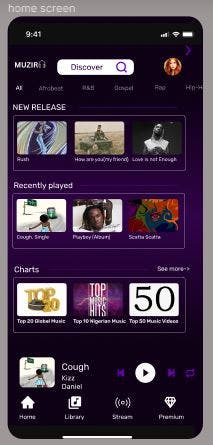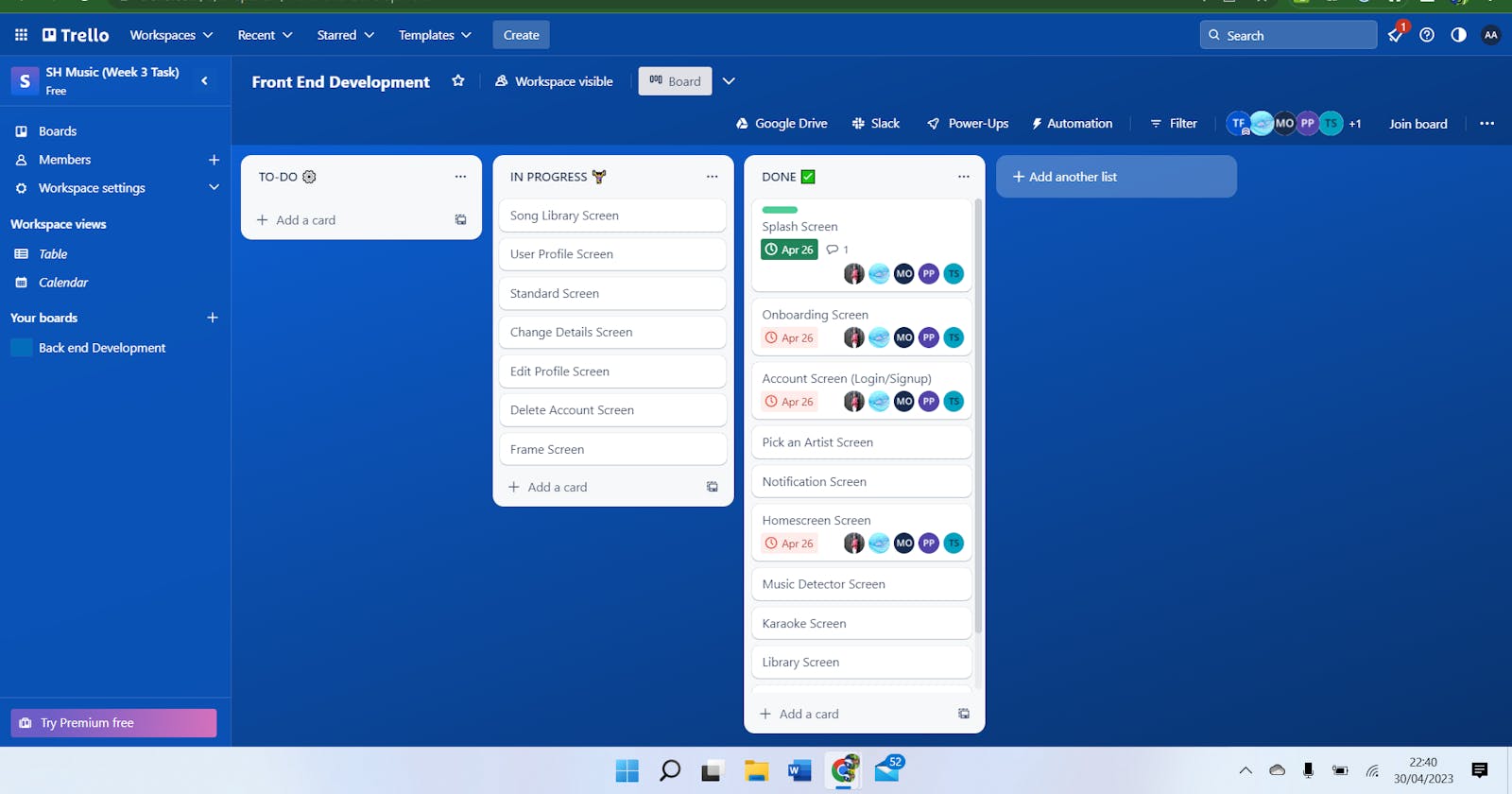Table of contents
- Task: Managing the Engineering team (Backend Team 2 and Frontend Team 1b) in conjunction with Product Management Teams 5,6,7 & 8 to Deliver a Music App named "SH Music App".
- Objective: Managing a team of Frontend and Backend Engineers in creating a music application.
- Timeline: Six (6) days
- Processes
- Day 1 (Monday, 24th April): Sprint Planning Ceremony
- Day 2 (Tuesday, 25th April): Daily Standup
- Day 3 (Wednesday, 26th April): Daily Standup
- Day 4 (Thursday, 27th April): Daily Standup
- Day 5 (Friday, 28th April): Daily Standup
- Day 6 (Saturday, 29th April): Daily Standup
- Day 7 (Sunday, 30th April): Sprint Review and Retrospective Meeting
- Sprint Review
- Sprint Retrospective
- Lessons Learnt

Task: Managing the Engineering team (Backend Team 2 and Frontend Team 1b) in conjunction with Product Management Teams 5,6,7 & 8 to Deliver a Music App named "SH Music App".
Objective: Managing a team of Frontend and Backend Engineers in creating a music application.
Timeline: Six (6) days
Processes
Day 1 (Monday, 24th April): Sprint Planning Ceremony
Immediately after we got the task from the Boot Camp Administrator, all the product Team Leads and assistant Team Leads of Teams 5 - 8 met to decide the direction our management of the engineers would take for the week’s task. After clarifying our direction and processes, we tried to contact the Backend and Frontend engineers. However, only the Backend engineers responded to our communication attempts, and we had a sprint planning meeting with them.
In the sprint planning meeting, we agreed to use Trello, chose the app name, and informed the Backend Team Lead to report to us about the tasks his team would need to complete for the app creation. We also agreed to have our daily standups at 9pm because mornings weren’t convenient for everyone. After the call, a PM Team Lead created the Trello workspace, enabling everyone to come in.
Day 2 (Tuesday, 25th April): Daily Standup
The Frontend Team Lead was finally able to join us during the daily standup at 9pm where he gave his excuses for missing the first day of the project. He also informed us that the project would be a herculean task for his team because they had a limited number of engineers available to work with us. In all transparency, he mentioned that only about four of them had been working on the previous projects, and maybe only two would be available for the project.
He eventually highlighted the tasks his team would handle to complete their part of the project. The Backend Team Lead also told us the tasks his team would undertake. A product manager, on behalf of others, created a board for each engineering team and added their tasks. Additionally, we explained how to move tasks on Trello to the engineers.
Day 3 (Wednesday, 26th April): Daily Standup
At the daily standup by 9pm, we asked the engineering teams what they did during the day, what they would do the next day, and the problems they faced. The Frontend Team Lead mentioned they had started working on the HTML file of the Splash Screen, and were going to complete it the next day. His reported problem was low participation among his teammates, with only two doing all the work.
The Backend Team Lead reported they had created the user database and the table for the signup page and would work on the user authentication the next day. His reported problem was that the Frontend team wasn’t moving as fast as them.
Day 4 (Thursday, 27th April): Daily Standup
At the daily standup, the Frontend Team Lead reported that he had completed the Splash Screen’s HTML, CSS, and styling. He also stated that he had moved the task to Done in the Trello workspace. He reiterated that there was low participation in his team, with him being the only participant in the project.
The Backend Team Lead reported that his team had completed the validation and authentication of the login and registration page. Additionally, he emphasised the slow speed of the Frontend team.
Day 5 (Friday, 28th April): Daily Standup
The Frontend Team Lead had no report concerning the tasks as he maintained that he had an incredibly busy personal life that prevented him from working on the project.
The Backend Team Lead reported that his team had created the music storage table and was writing the API to display the contents. He mentioned having a problem with uploading documents of code. The product managers advised him to research properly on the problem.
Day 6 (Saturday, 29th April): Daily Standup
There was no daily standup because all Product Management teams had a review meeting with the Bootcamp Administrator.
Day 7 (Sunday, 30th April): Sprint Review and Retrospective Meeting
The sprint review and retrospective meeting started at 3.00pm and lasted till 5:30pm. In the meeting, we reviewed how far the project had come. The Frontend Team Lead explained that he had completed 11 screens out of 18. The Backend Team Lead reported that his team had completed all their tasks. We completed the review and discussed the retrospective.
Sprint Review
We could not complete the application within the timeline because the Frontend development team stopped at the stream screen. They had a couple more screens to complete but couldn't meet up because they had insufficient engineers.
Tasks Completed (Frontend)
Splash Screen
Onboarding Screen
Login/Signup Screen
Pick an Artist Screen
Notification Screen
Homescreen Screen
Music Detector Screen
Karaoke Screen
Library Screen
Lyrics Screen
Stream Screen
Tasks Completed (Backend)
User database creation
Music file storage creation
Music search bar creation
Music library creation
Tasks Incomplete and In Progress (Frontend)
Song Library Screen
User Profile Screen
Standard Screen
Change Details Screen
Edit Profile Screen
Delete Account Screen
Frame Screen
Sprint Retrospective
What Went Well
A Frontend engineer was used to the processes of creating an app.
Backend engineers were familiar with Zamp for the app database.
Product management Team Leads collaborated amongst themselves adequately when moderating daily standups and conducting the sprint planning, review and retrospective meetings.
There was a large turnout of product managers from each team at every meeting.
Onboarding the participating engineers to the Trello workspace went smoothly.
What Didn't Go Well
We could not contact all the essential engineers until the 3rd day.
The Backend and Frontend teams were understaffed, with only 2 engineers from each team working with us.
The other Frontend engineer was not familiar with the processes.
We could not complete the app within the set time because the frontend team didn’t complete tasks within time.
Backend engineers could not host the app because they mentioned it needed money.
Engineers were late to Scrum ceremonies.
Lessons Learnt
We understand that the task was more of a mock project. Still, working in an ideal (real-life) situation, the development team should have adequate team members ranging from developers to designers.
Jira’s free software doesn’t accommodate more than 10 users. Any project that would have more than 10 persons may use Trello instead.
Working with competent hands is critical in achieving a task/project.
Managers shouldn’t be more than engineers.

